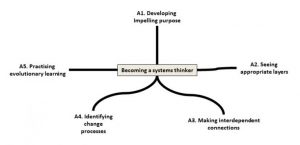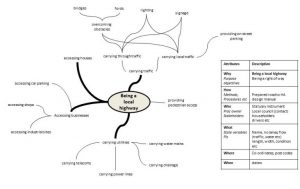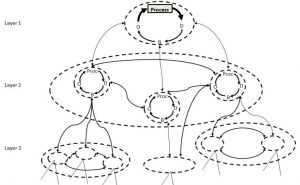Tony Buzan invented mind maps as a simple tool for thinking through the issues relevant to a problem.
We use them to develop our process models. The technique is actually very simple. Let’s illustrate it here by writing a mind map for becoming a systems thinker based on our axioms. Our top level process – the process we want to execute is Becoming a systems thinker. So we write that proposition at the centre of the diagram. If we think that our axioms are together logically necessary and sufficient for success in the process then they can be added to the diagram as below.
Notice that in every case we use the ‘ing’ form – the present participle to give a sense of process and not just simply a statement or proposition.
Next we show an example of a mind map to develop the processes around the maintenance of a physical system like a highway.

The diagram is for illustration only and is not comprehensive as would be required in practice. Next for each process in the mind map we begin to write down the six important parameters of a process – why, how, who, what, where and when as illustrated above in the table.
To help you begin to see how mind map can be used quite generally across a range of systems below is an illustration of a hierarchy of layers of self-similar process loops as described on our process pages. They are Designing (D), Building (B) and Operating (O).

But these engineering terms (designing, building and operating) can be interpreted more generally and within different contexts. For example in the scientific method we see the conceptual equivalent to designing as conjecturing i.e. creating ideas. In engineering design is creating a new product/system whereas in science creating is conjecturing a new hypothesis or theory. In engineering building is the making of the idea into a physical reality that will be tested as it is developed and then used in practice. In science a hypothesis is tested in an experiment or against some specific criteria to see if it has some confirmation in reality. In engineering operating is using the product/system and finding out if it workd well. In science operating is the wider testing by many people together with its use in practice to find out how well it confirms explanations or predicts new results. Here the theory is evaluated and confirming or falsified. In both engineering and science much is learned from all three phases.
So thinking of the process of engineering designing much more generally we can suggest that in other contexts it is equivalent to sensing, perceiving, specifying, planning, conjecturing or wondering.
Likewise building is equivalent to manufacturing, thinking, reflecting, establishing, making, writing and testing.
And operating is equivalent to acting, using, doing, running, evaluating, experiencing or learning.
In this way we can begin to see how to integrate ideas and systems by synthesising similarities rather than analysing differences.
